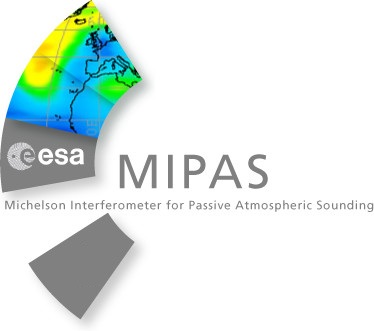
MIPAS

MIPAS is an atmospheric sensor on board the European satellite ENVISAT launched in March 2002. Designed as a high-resolution limb sounder, it provides detailed insights into the chemistry of the atmosphere by observing emission spectra in the near to mid-infrared. This information enhances studies of the composition, dynamics and radiation balance of the middle atmosphere (stratosphere+mesosphere) and the upper part of the troposphere.
The atmosphere at the Earth's limb is observed by MIPAS covering a possible altitude range from 5 to 150 km with a vertical resolution of about 3 km. MIPAS enables to retrieve vertical trace gas profiles of over 20 species day and night. Global coverage is obtained within 3 days. As one of the atmospheric instruments on ENVISAT, MIPAS complements information obtained by SCIAMACHY, GOMOS and MERIS.
Available Data
MIPAS standard data products comprise localized calibrated emission spectra (Level 1) and stratospheric trace gas profiles of H2O, O3, HNO3, CH4, N2O and NO2 (Level 2). These products are available from ESA via the German Processing and Archiving Center (D-PAC) located at the German Remote Sensing Data Center (DFD).
Assimilated chemical observations of MIPAS (Level 4) can be obtained here from WDC-RSAT.
Links
- MIPAS Homepage at ESA.
- Browse the MIPAS Product Handbook.
- Check the current and historic MIPAS instrument availability in space.
- The MIPAS Data Sheet from WDC-RSAT.
- A short MIPAS tour by ESA.
- MIPAS Group at the University of Oxford.
- BASCOE - Belgian Assimilation System of Chemical Observations from ENVISAT.
- MIPAS Page of the Italian Istituto di Fisica Applicata "Nello Carrara".
- MIPAS Studies at Leicester University.
- There is a long history of the MIPAS sensor. First it was used as a ground-based instrument, then as a balloon borne version, then on aircraft, and finally it became suitable for operation in space.
- Download the BEAT software package for reading ESA MIPAS data prodcuts here.
Contact
If you would like to know more about the MIPAS instrument, see the following points of contact:
- Contact the MIPAS Team at Forschungszentrum Karlsruhe, Germany.
- Contact wdc@dlr.de for valued added MIPAS data products.